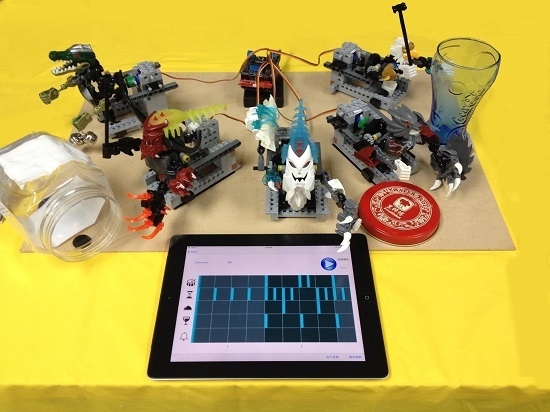Interactive Rhythm Learning System by Combining Tablet Computers and Robots
Abstract
:1. Introduction
- Teaching through physical movements: Teachers play music and guide children in moving their bodies to music, thus enabling the children to experience rhythms through various physical movements [2].
- Teaching using musical instruments: This is the most common method. By playing with various musical instruments, children learn about aspects of music (e.g., scales, notes, musical scores, melody, and rhythm).
2. Rhythm Teaching System
2.1. Musical Score Editing and Playing Functions
2.2. Rhythm Rating Function
3. Interactive Robot Performance System
4. Experimental Course and Field Trials
- The proposed rhythm rating function was used for assessment. This function played a test melody, during which the students were required to perform rhythms along with the melody. The system then recorded the number of beats that the students played accurately.
- When the students used snare drums to play songs along with the melodies, their performance was observed and assessed.
- Children face difficulty performing complex rhythms on their own. However, through our system, children can learn to play complex rhythms using simple system operations.
- Children who have a tendency to hit items with a stick show a willingness to spend more time editing their own rhythm-based sheet music after using our system.
- Because the robot plays self-created music, after listening to a particular piece of music several times, most children learn about how to edit the sheet music to produce the songs they want to play.
- The robot performance attracts children’s attention and increases their willingness to learn.
- In the field trials, the loud music and actions produced by the robot performance system drew attention from numerous adults and children. The audience gave positive feedback regarding the system’s novel and interesting design concept. They agreed that our system provides the users with a pleasant experience through its interactive features. Because the score could be easily edited, this also prompts them to adjust the input score in order to create more amusing rhythms.
5. Comparison of Rhythm Apps
- During the field-trail process, most participating parents did not like having their children spend excessive time on these apps. Some parents were concerned that long-term usage of mobile devices would impair their children’s vision.
- During the field-trail process, we found that children were spending a small amount of time on rhythm training and an excessive amount of time on in-app minigames unrelated to rhythm training.
- Although the Carnival of Animals and Rhythm Training apps had interesting and attractive interfaces, these apps had monotonous audio feedback and operation, and learners may become bored after one or two uses. In addition, these apps allowed practice with only minimal rhythm combinations and do not allow customization.
- For the Monkey Drum app, children could tap the mobile device in whatever rhythm they desire. However, this app had poor interactivity and monotonous playback and was unable to keep children’s long-term interest.
- Although the Woodchuck Rhythm app applied seven rhythm patterns, each of which had corresponding scores, cartoon graphics, and audio file. However, this app had only a small rhythm library and did not include rhythms with long beats (e.g., half notes)
6. Conclusions and Future Works
Acknowledgments
Author Contributions
Conflicts of Interest
Appendix A
| No heading line Course Title | An experimental course on the use of interactive teaching aids in musical rhythm education |
| Topic | Training one’s sense of musical rhythm |
| Source of Teaching Materials | Self-compiled, together with reference books |
| Teaching Aids Used | Castanets, maracas, an iPad, and an interactive robot performance system |
| Target students | Preschool Levels 2 and 3 (5–6-year-olds) |
| Number and Length of Classes | Four 50-min classes |
| Course Objectives | To incorporate teaching aids designed in this study into traditional rhythm education to improve students’ sense of rhythm and musical performance skills in addition to elevating their willingness to learn |
| Course Content | Task 1: |
| Musical rhythms were created using the body to imitate produce a variety of rhythms and train students to feel rhythmic changes. Next, students were encouraged to improvise and create different rhythms. Subsequently, the nursery rhyme “Two Tigers” (“Frère Jacques” in French) was played, and students were asked to replicate the rhythms in accordance with the rhythm of the song. | |
| Task 2: | |
| Students were taught quarter notes and eighth notes, in addition to training them to recognize the speed differences between them. First, students were asked to perform music using maracas and castanets. Subsequently, the proposed rhythm rating function in iPad was applied to facilitate rhythm training and improve the accuracy of rhythmic beating. | |
| Task 3: | |
| Students were taught to play snare drums using their hands to create different rhythms. First, robots played according to a score, and the children listened to them and observed their movements. The rhythm was composed of quarter and eighth notes. Subsequently, the children were asked to replicate in accordance with the rhythm of “Two Tigers” by using small snare drums and repeat practicing what they have learned. | |
| Task 4: | |
| The Chinese nursery rhymes “Two Tigers” and “Speeding Train” were played using the interactive robot performance system. Students were instructed to replicate the rhythms using snare drums according to and along with the rhythm of the songs. | |
| Assessment Method | A test was administered to each student before and after the rhythm training. The test methods are described as follows: |
| 1. The proposed rhythm rating function was used for assessment. This function played a test melody, during which the students were required to perform rhythms along with the melody. The system then recorded the number of beats that the students played accurately. | |
| 2. When the students used snare drums to play songs along with the melodies, their performance was observed and assessed. |
References
- Eduard, H. Vom Musikalisch-Schönen: Ein Beitrag zur Revision der Ästhetik der Tonkunst; JA Barth: Leipzig, Germany, 1854. [Google Scholar]
- Rea, P. Experiences in Movement with Music, Activities, and Theory; Delmar Publishers: New York, NY, USA, 1995. [Google Scholar]
- Bae, J.; Lee, B.; Cho, S.; Heo, Y.; Bang, H. Drum On: Interactive personal instrument learning system. In Proceedings of the SIGGRAPH Emerging Technologies, Los Angeles, CA, USA, 5–9 August 2012.
- Kanke, H.; Terada, T.; Tsukamoto, M. A Percussion Learning System Using Rhythm Internalization with Haptic Indications. In Proceedings of the 12th International Conference on Advances in Computer Entertainment Technology, Iskandar, Malaysia, 16–19 November 2015.
- Li, W.H.A.; Fu, H. Augmented reflection of reality. In Proceedings of the SIGGRAPH Emerging Technologies, Los Angeles, CA, USA, 5–9 August 2012.
- Baba, T.; Kikukawa, Y.; Yoshiike, T.; Suzuki, T.; Shoji, R.; Kushiyama, K. Gosen: A Handwritten Notational Interface for Musical Performance and Learning Music. In Proceedings of the SIGGRAPH Emerging Technologies, Los Angeles, CA, USA, 5–9 August 2012.
- Raymaekers, L.; Vermeulen, J.; Luyten, K.; Coninx, K. Game of tones: Learning to play songs on a piano using projected instructions and games. In Proceedings of the CHI 2014, Toronto, ON, Canada, 26 April–1 May 2014; pp. 411–414.
- Tsui, C.K.; Law, C.H.; Fu, H. One-Man Orchestra: Conducting Smartphone Orchestra. In Proceedings of the SIGGRAPH Emerging Technologies, Los Angeles, CA, USA, 5–9 August 2012.
- Bengler, B.; Bryan-Kinn, N. Designing collaborative musical experiences for broad audiences. In Proceedings of the 9th ACM Conference on Creativity & Cognition, Sydney, Australia, 17–20 June 2013; pp. 234–242.
- Yazdi, K.M.; Lee, S.P. E-Santur: A customizable tool for learning Santur music instrument using game-based learning approach. In Proceedings of the 2011 International Conference on Research and Innovation in Information Systems, Kuala Lumpur, Malaysia, 23–24 November 2011.
- Waranusast, R.; Bang-ngoen, A.; Thipakorn, J. Interactive Tangible User Interface for Music Learning. In Proceedings of the 28th International Conference on Image and Vision Computing New Zealand, Wellington, New Zealand, 27–29 November 2013.
- Hoffman, G.; Weinberg, G. Shimon: An Interactive Improvisational Robotic Marimba Player. In Proceedings of the CHI 2010, Atlanta, GA, USA, 10–15 April 2010; pp. 3097–3102.
- Rasamimanana, N.; Bevilacqua, F.; Bloit, J.; Schnell, N.; Flety, E.; Cera, A.; Frechin, J.L.; Petrevski, U. The Urban Musical Game: Using Sport Balls as Musical Interfaces. In Proceedings of the CHI 2012, Austin, TX, USA, 5–10 May 2012; pp. 1027–1030.
- Lee, J.; Gea, A.; Levin, N.; Yang, C.; Deciron, R.; Lee, M.; Lu, P.L.; Xie, M. TuneTrain: Incidental Learning Through Interactive Music Creation. In Proceedings of the 2013 IEEE International Games Innovation Conference (IGIC), Vancouver, UK, 23–25 September 2013; pp. 130–133.
- Toothy Buddies. Carnival of Animals: Music Education for Your Kids. Available online: http://www.toothybuddies.com/carnival-of-the-animals/tw/ (accessed on 4 June 2013).
- Apple Inc. GaragBand. Available online: http://www.apple.com/tw/ios/garageband/ (accessed on 10 March 2011).
- Wood, M. Woodchuck Rhythm. Available online: https://itunes.apple.com/tw/app/woodchuck-rhythm/id633329909?mt=8 (accessed on 8 March 2014).
- Tak, L.C. Rhythm Training. Available online: https://itunes.apple.com/us/app/rhythm-training-sight-reading/id517896059?mt=8 (accessed on 29 April 2012).
- Flippfly LLC. Monkey Drum. Available online: https://itunes.apple.com/us/app/monkey-drum/id483225765?mt=8 (accessed on 31 May 2012).
- Drum Score. Available online: http://dp-notebook.blogspot.tw/2013/09/blog-post.html (accessed on 7 September 2013).
- Arduino UNO. Available online: https://www.arduino.cc/en/Main/ArduinoBoardUno (accessed on 1 December 2006).

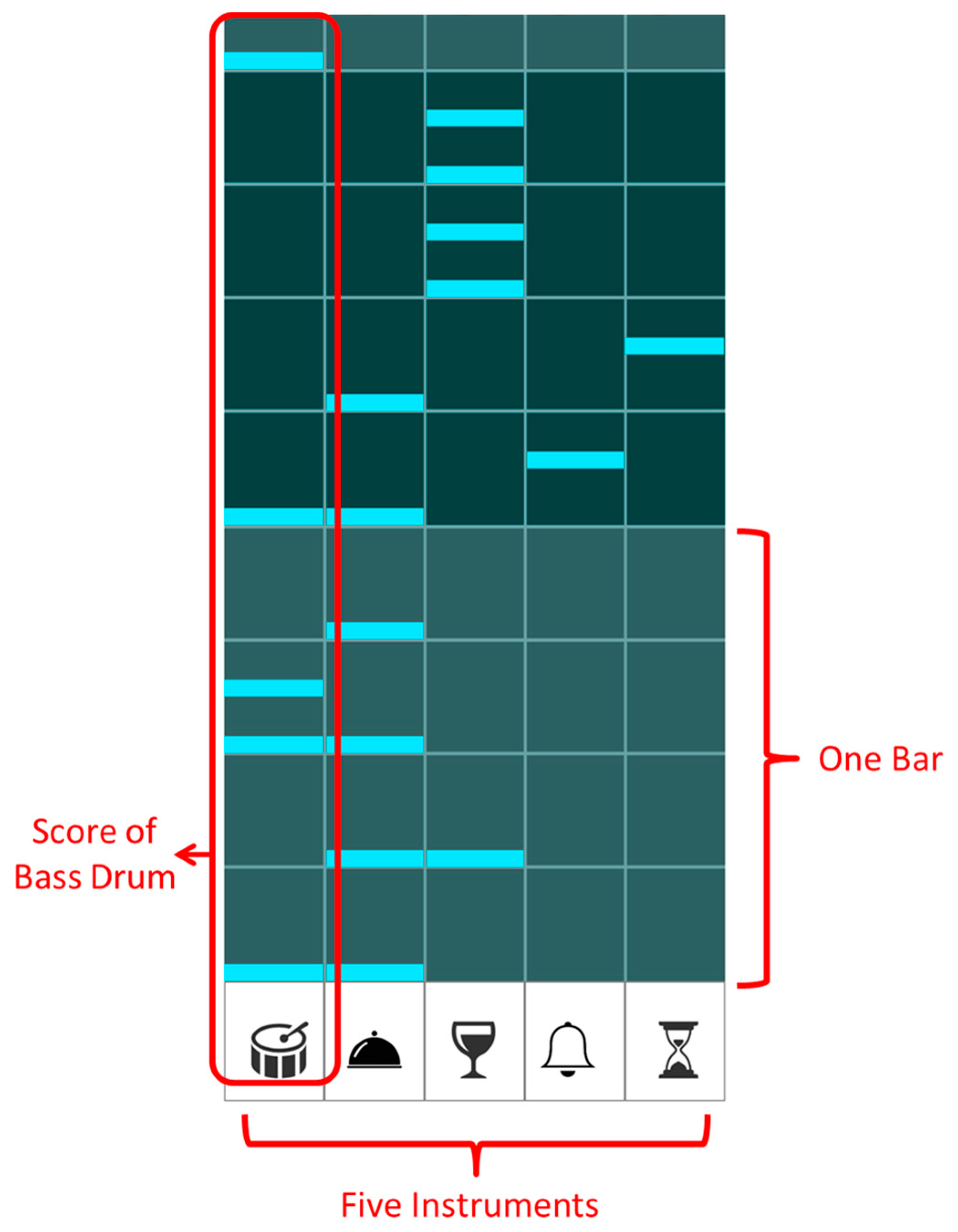

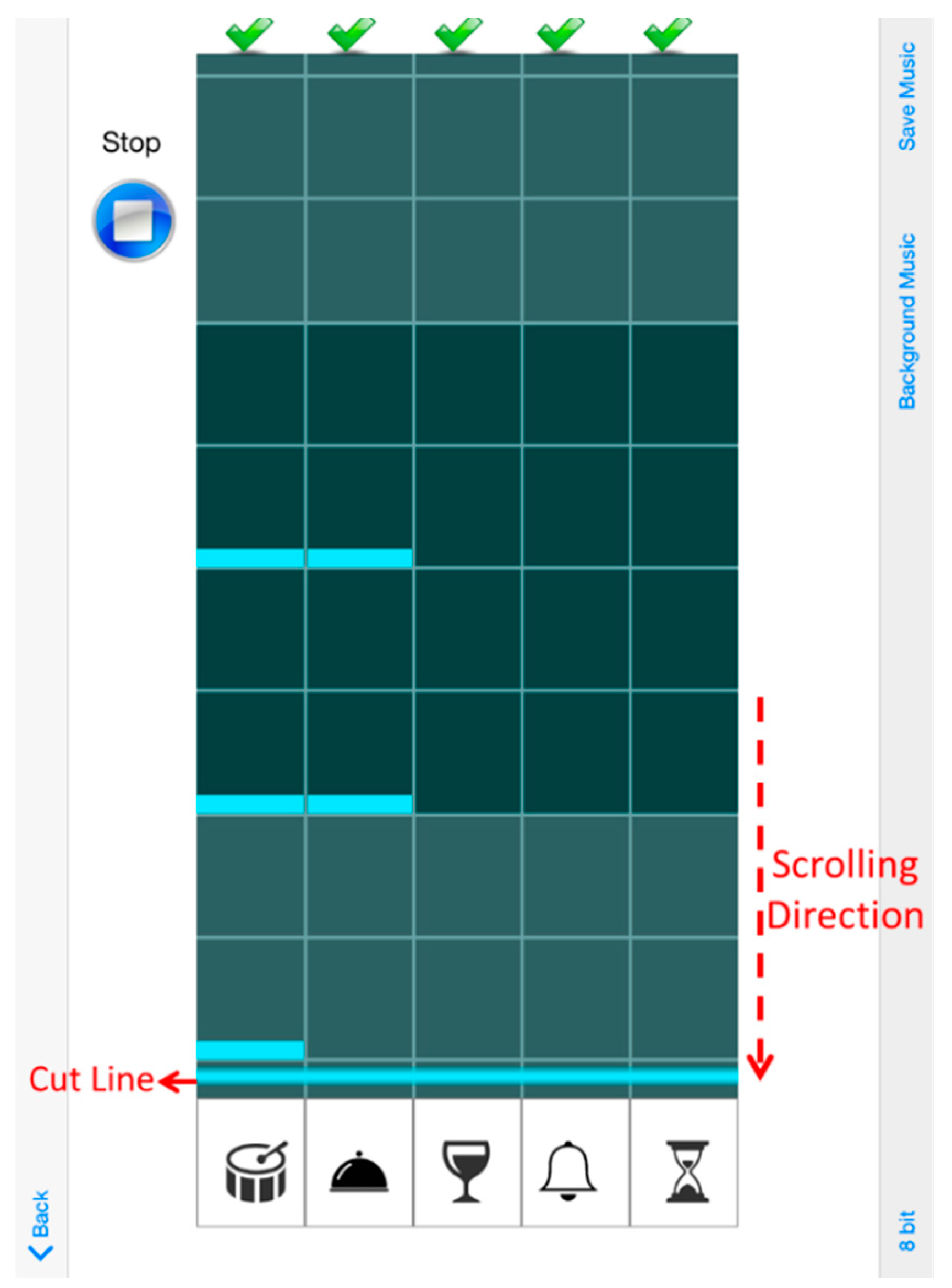
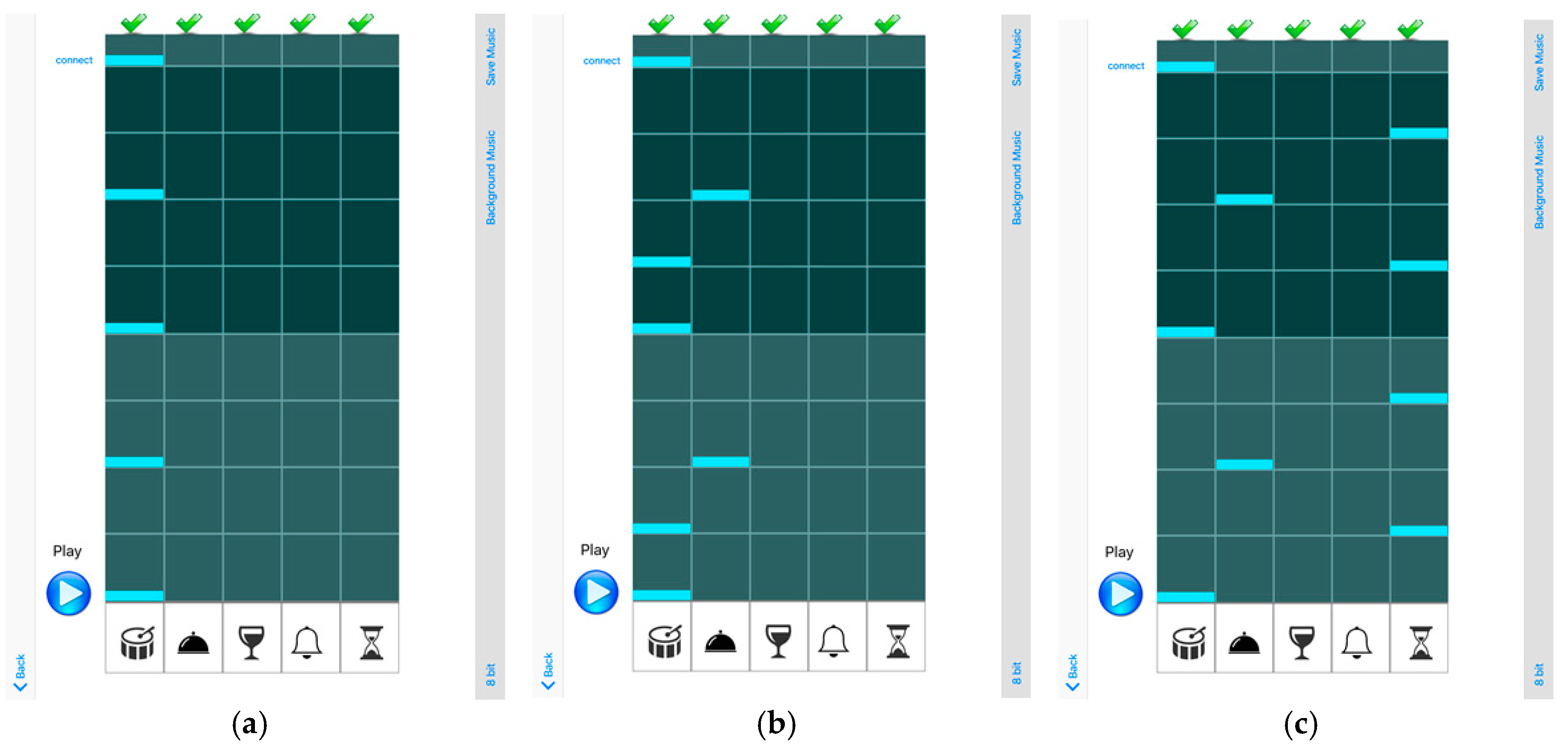
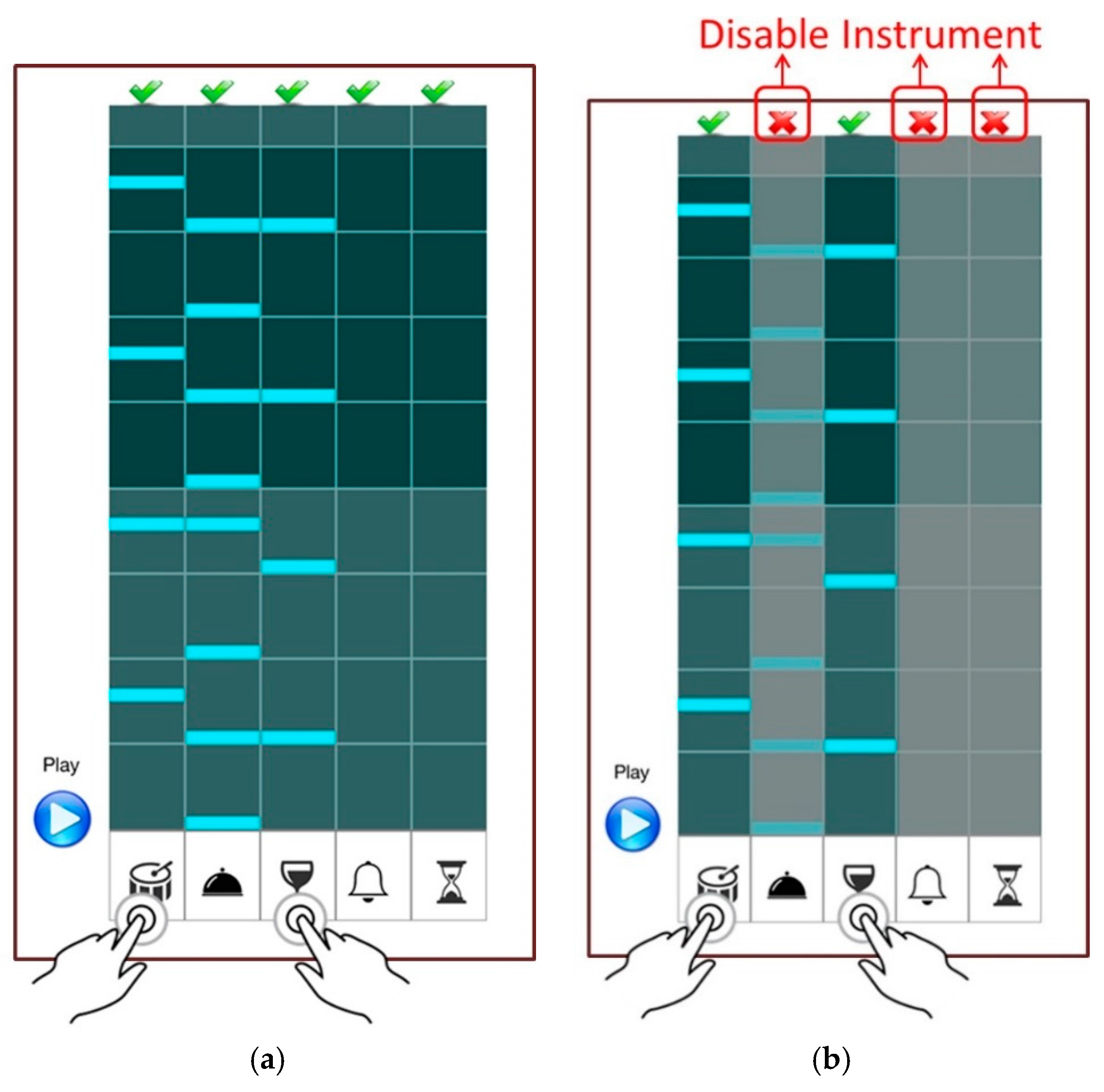
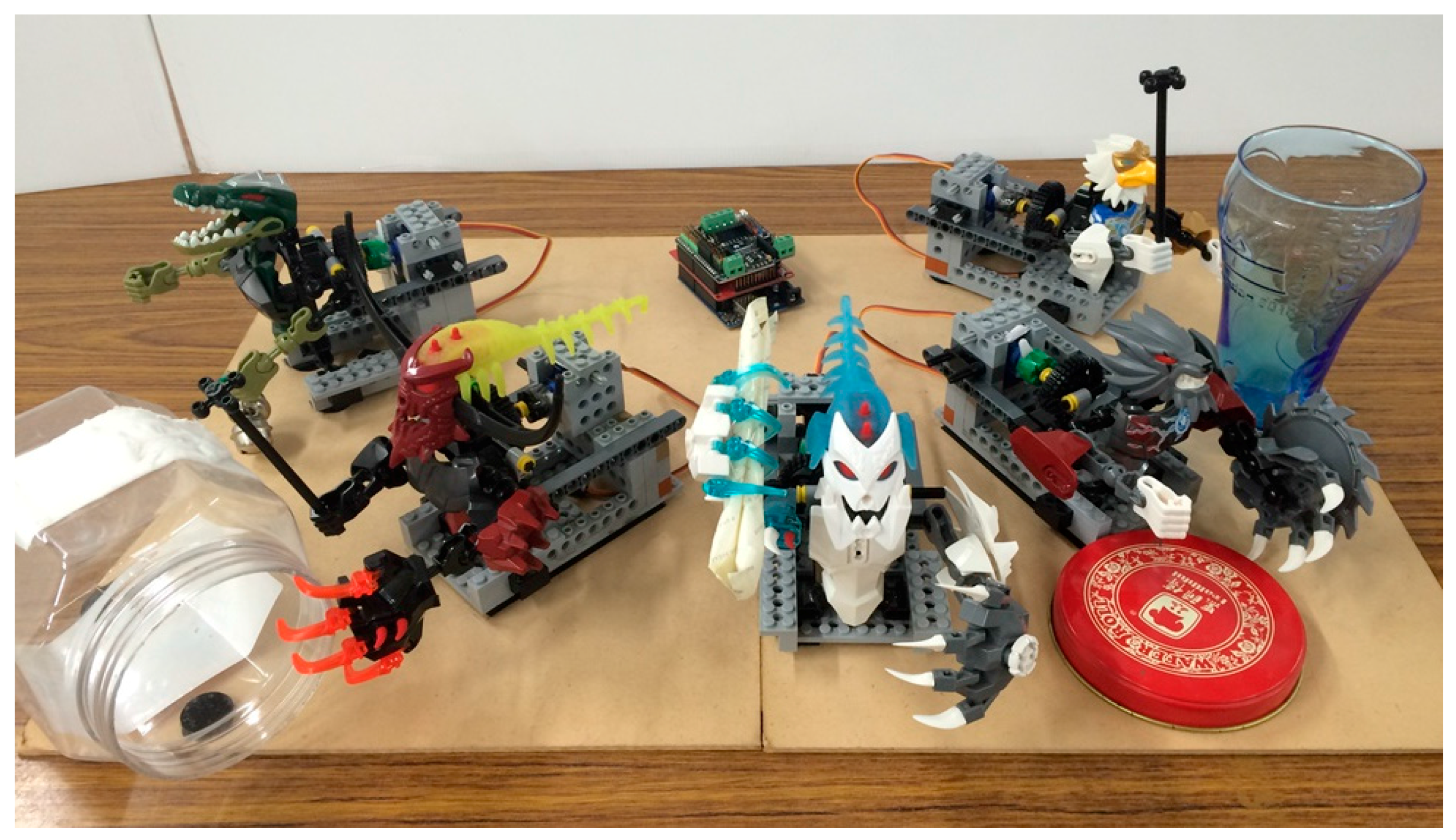
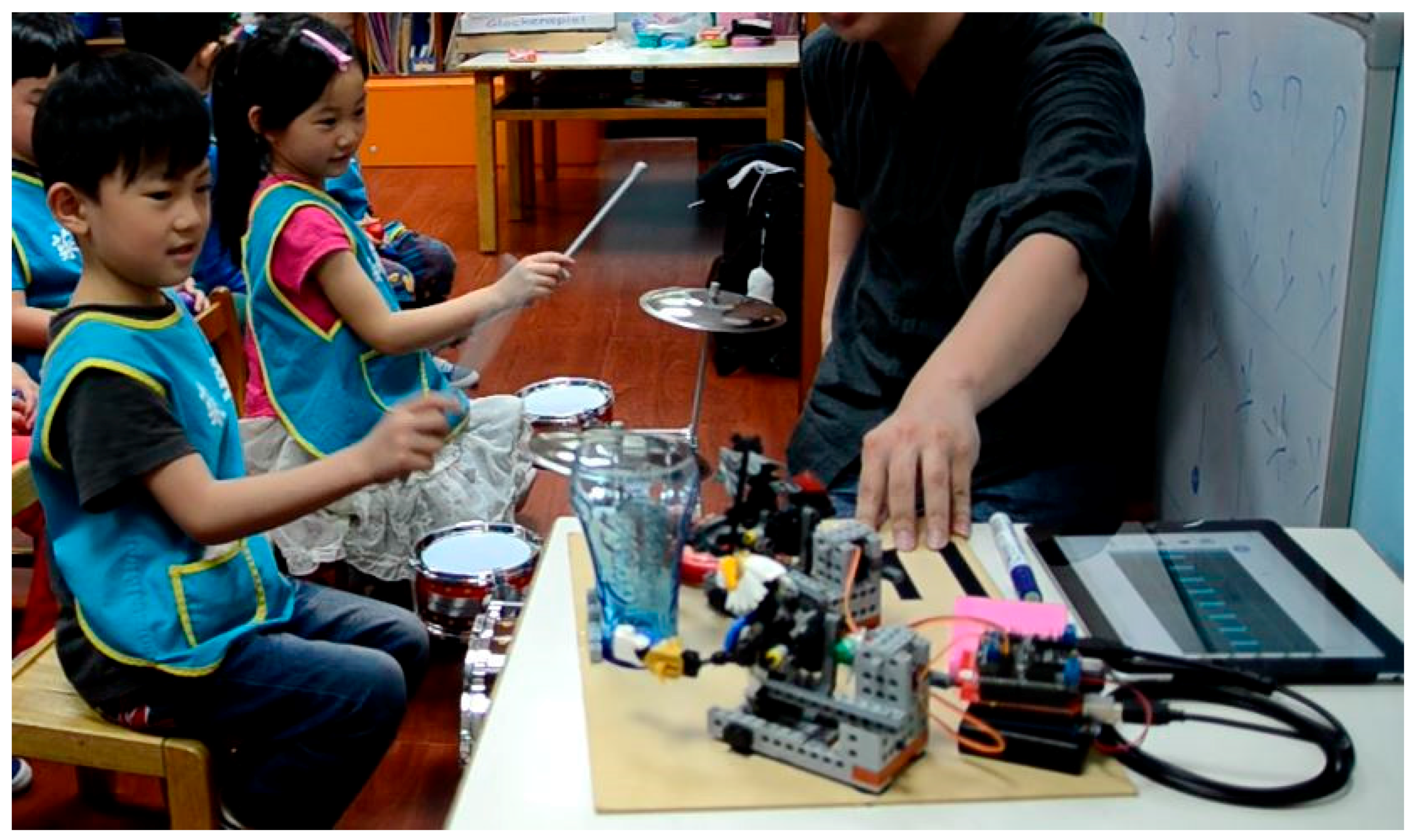
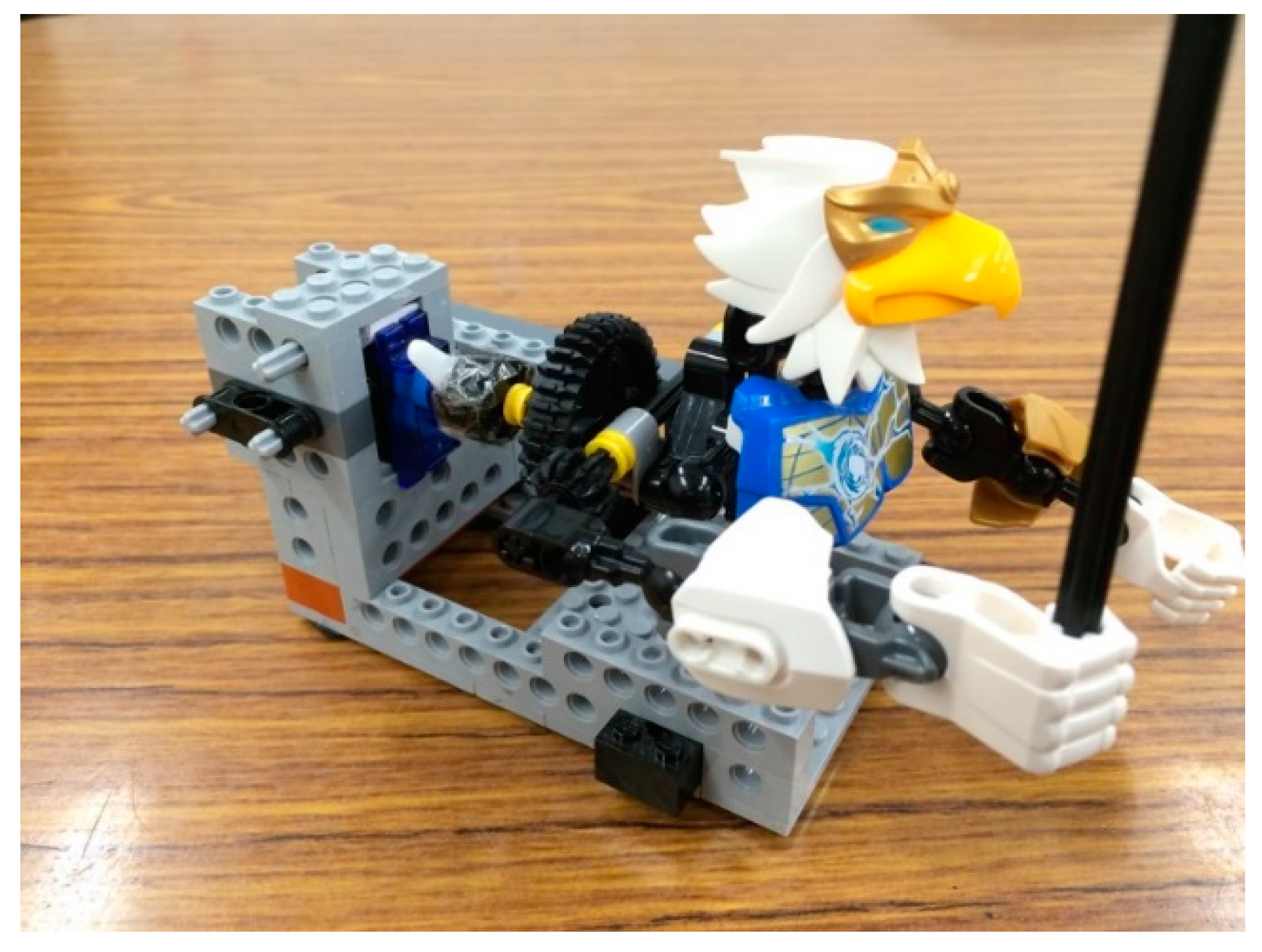
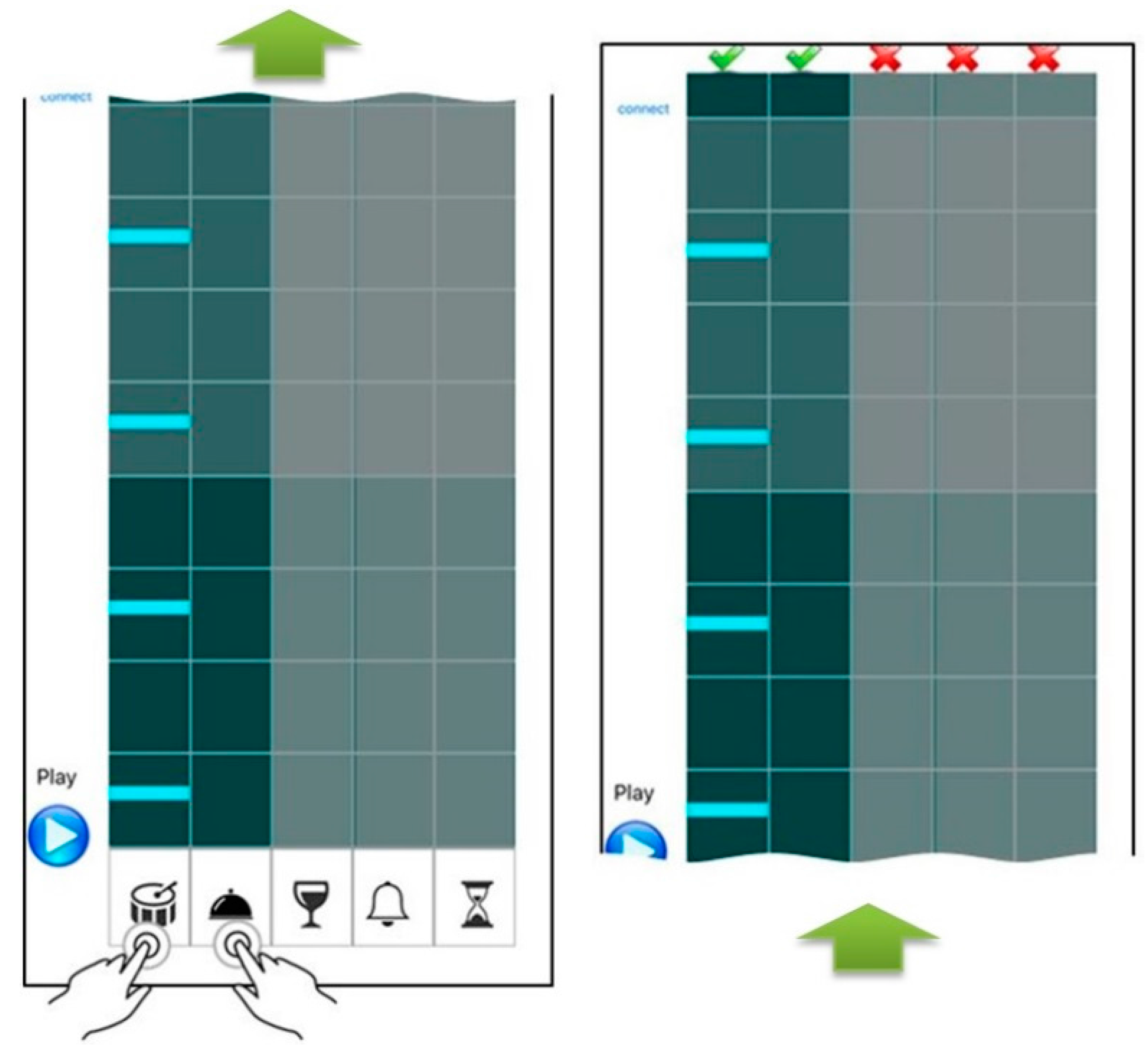
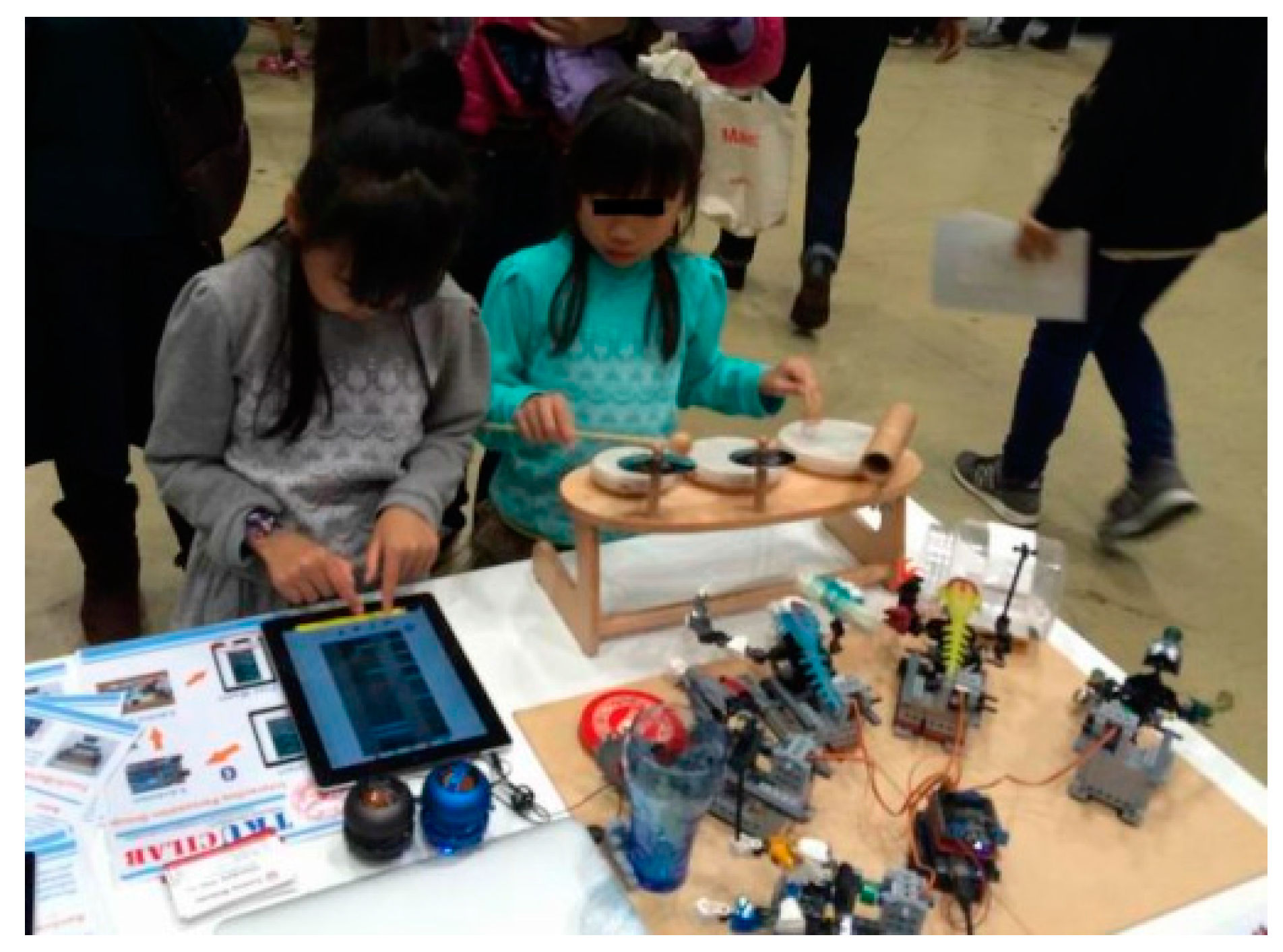
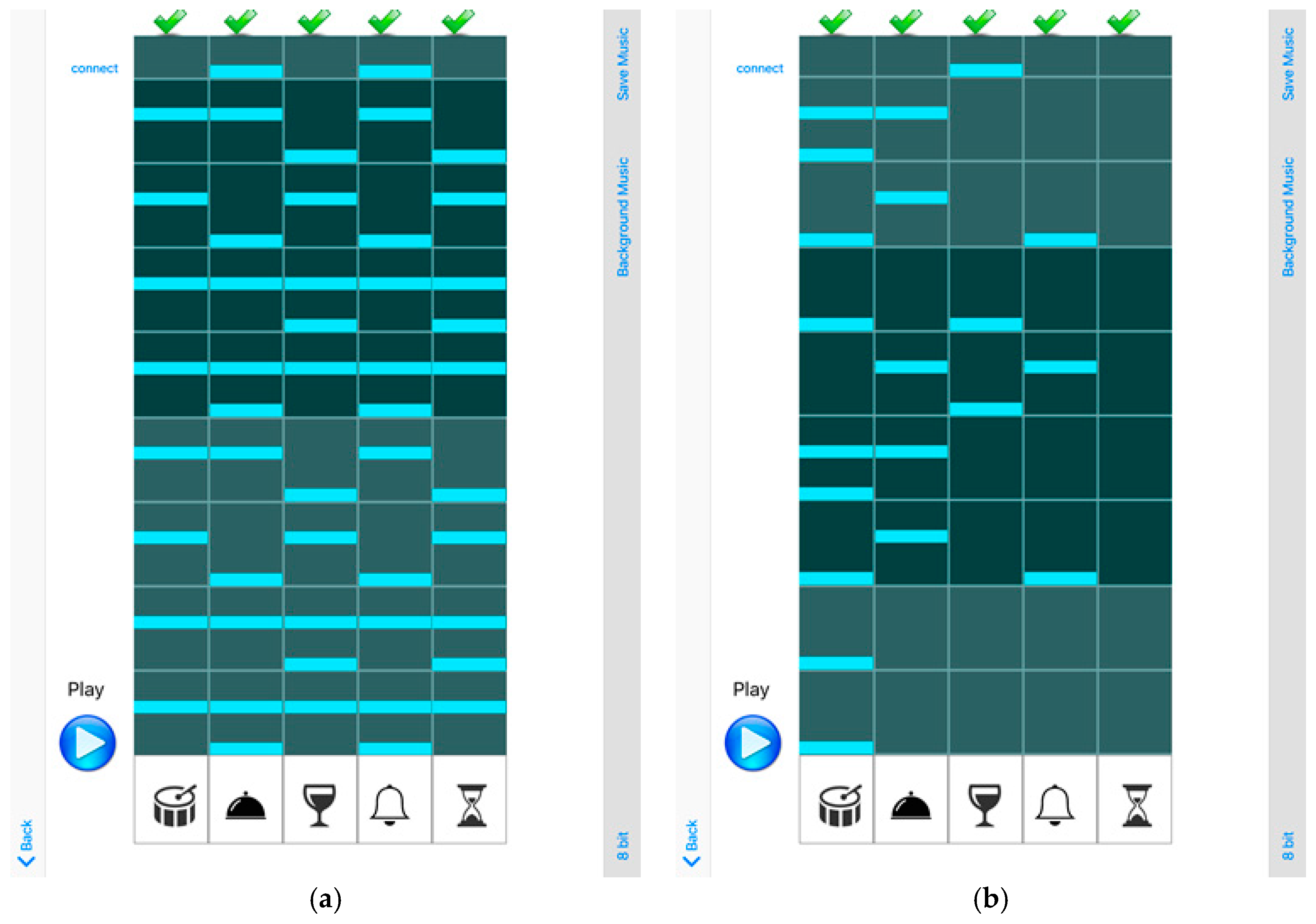
| Sound Type | Object Selected in Our Drum Set | Instrument Type |
|---|---|---|
| Low-Frequency Sound | Plastic Bucket | Bass Drum |
| High-Frequency Sound | Iron Lid | Snare Drum |
| Sound with Some Fermata | Sugar Sachet | Hi-Hat |
| Loud Sound | Glass, Bell | Crash Cymbal |
| Student ID | Testing before the Rhythm Education | Testing after the Rhythm Education | ||||
|---|---|---|---|---|---|---|
| Beating Number | Correct Beating | Accuracy of Beating | Beating Number | Correct Beating | Accuracy of Beating | |
| A | 38 | 18 | 47.37% | 52 | 19 | 36.54% |
| B | 26 | 11 | 42.31% | 27 | 23 | 85.19% |
| C | 31 | 14 | 45.16% | 25 | 19 | 76.00% |
| D | 26 | 21 | 80.77% | 26 | 24 | 92.31% |
| E | 26 | 18 | 69.23% | 27 | 20 | 74.07% |
| F | 27 | 12 | 44.44% | 25 | 21 | 84.00% |
| G | 26 | 18 | 69.23% | 25 | 22 | 88.00% |
| H | 61 | 24 | 39.34% | 24 | 16 | 66.67% |
| I | 25 | 23 | 92.00% | 26 | 25 | 96.15% |
| J | 34 | 21 | 61.76% | 26 | 25 | 96.15% |
| Average Beating Accuracy | 59.16% | 79.51% | ||||
| Heading | Our System | Carnival of Animals [15] | Woodchuck Rhythm [16] | Rhythm Training [17] | Monkey Drum [18] |
|---|---|---|---|---|---|
| Interactivity | ✓ | ✓ | ✓ | ||
| Notation Learning | ✓ | ✓ | |||
| Note Value Learning | ✓ | ✓ | ✓ | ✓ | |
| Variety of Musical Instruments | ✓ | ✓ | ✓ | ||
| Create and Edit Drum Scores | ✓ | ✓ | |||
| Difficulty Adjustment | ✓ | ✓ | |||
| In-app Simulation of Percussion Instruments | ✓ | ✓ | ✓ |
| Student ID | Testing before the Field Trail | Testing after the Field Trail | ||||
|---|---|---|---|---|---|---|
| Beating Number | Correct Beating | Accuracy of Beating | Beating Number | Correct Beating | Accuracy of Beating | |
| A | 25 | 18 | 72% | 25 | 21 | 84% |
| B | 25 | 17 | 68% | 25 | 19 | 76% |
| C | 25 | 22 | 88% | 25 | 24 | 96% |
| Average Beating Accuracy | 76% | 85.33% | ||||
© 2017 by the authors. Licensee MDPI, Basel, Switzerland. This article is an open access article distributed under the terms and conditions of the Creative Commons Attribution (CC BY) license ( http://creativecommons.org/licenses/by/4.0/).
Share and Cite
Chou, C.-H.; Chu, Y.-L. Interactive Rhythm Learning System by Combining Tablet Computers and Robots. Appl. Sci. 2017, 7, 258. https://doi.org/10.3390/app7030258
Chou C-H, Chu Y-L. Interactive Rhythm Learning System by Combining Tablet Computers and Robots. Applied Sciences. 2017; 7(3):258. https://doi.org/10.3390/app7030258
Chicago/Turabian StyleChou, Chien-Hsing, and Yung-Long Chu. 2017. "Interactive Rhythm Learning System by Combining Tablet Computers and Robots" Applied Sciences 7, no. 3: 258. https://doi.org/10.3390/app7030258
APA StyleChou, C.-H., & Chu, Y.-L. (2017). Interactive Rhythm Learning System by Combining Tablet Computers and Robots. Applied Sciences, 7(3), 258. https://doi.org/10.3390/app7030258





